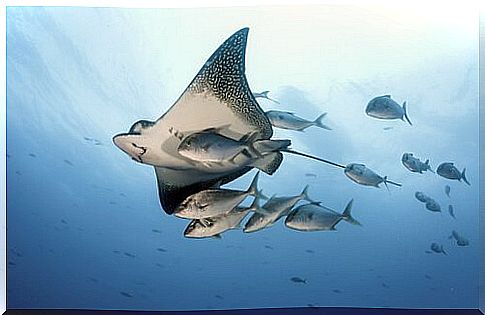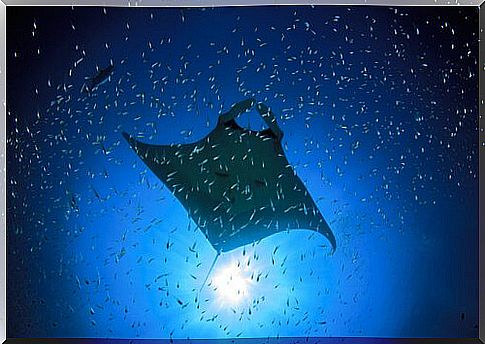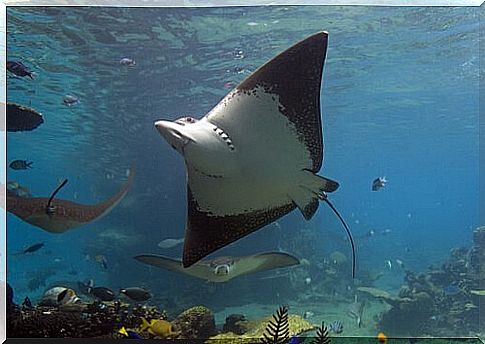Little-known Marine Species: Rays

Rays form a large order of cartilaginous fish that are characterized by their flat and thin body, with two pectoral fins and a long tail.
Despite their morphological differences, they are closely related to sharks.
In this article, we’ll talk about this little-known marine species. In addition to their physical characteristics, we will also analyze their habitat, food and reproduction.
Morphological characteristics of rays
Some of the most outstanding features of these fish are their triangular pectoral fins and their flat dorsoventral area.
They are also characterized by their endoskeleton with a fully cartilaginous structure and also fused frontal vertebrae.
The large size and wave of the fins are essential for the displacement of the rays, which allows their body to be propelled by the water. On the other hand, its tail fin may be short or non-existent, and it does not have an anal fin.
The tail has a whip-like structure: it is long, sharp and thin. It is usually covered with small splinters or sharp tongues, which can contain certain toxins. Some species have a venomous stinger that can reach up to 30 centimeters in length.
Their corneas are almost always attached to the skin around the eyes, with an absence of the nictizing membrane (third eyelid).

Ray Habitat
The vast majority of rays inhabit bodies of salt water and spread across all oceans on our planet.
Their adaptability is remarkable, as they can live in coastal areas as well as in the open sea and at depths of up to 3,000 meters.
However, there are also striped species adapted to freshwater, which live in estuaries or rivers.
Among them, we find the so-called “peacock’s eye rays”, native to South America, which live mainly in the Amazon basin. These species are recognized and feared for the powerful toxin in their harpoons.
Most of the freshwater or saltwater rays are benthic: they usually remain on the seabed. This habit makes it easier to protect against potential predators.
By flapping their fins, the rays manage to shake off the sand and partially bury their body to camouflage themselves and outwit their attackers.
Some species, such as the famous devil’s ray, are used to crossing the oceans: they are pelagic rays.
swimming method and behavior
The streak swimming method combines the lateral movements of its tail with the waves of its fins; to propel your body through water.
Despite moving with great elegance, lanes are not particularly agile when swimming. Another curious and infrequent habit of rays is jumping out of the water, which leaves much of their body in sight.
It is estimated that this practice is aimed at getting rid of parasites that can attach themselves to your skin.

Regarding social behavior, we can observe different habits according to the type of streak we analyzed.
Some rays are very social and live in large groups that hunt together and protect all of their members. But there are also some of the solitary habits that only gather during the breeding season.
Ray feeding
Most of these fish maintain a strictly carnivorous diet: they eat shellfish, fish and invertebrates that they find near the bottom of the sea.
There are also species that consume a lot of plankton to supplement their diet. The eyes of rays are at the top of their dorsoventral region, also called the disc.
To hunt, these fish mainly use a system of sensors, which allows them to identify the location of their prey and thus guarantee the effectiveness of their attack.
attacks and stings
In general, these curious marine animals have a balanced behavior and are very reserved.
Attacks or stings often happen when they feel threatened by the presence of strangers in their territory.
If you suffer a stingray bite and there is no health center nearby, it is recommended to remove the splinters with pliers. Never do this with your hands or teeth to avoid contact with any toxins.
Then, the affected region should be submerged in hot water for 30 to 60 minutes (taking care not to burn).
After first aid, it will be essential to seek specialized care in health centers or lifeguards.









